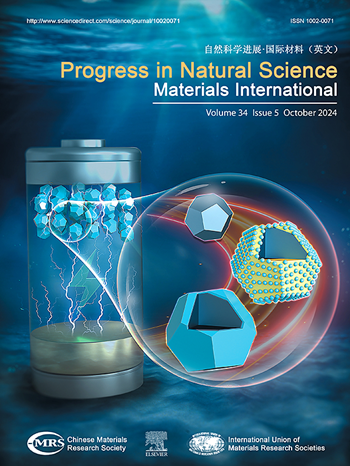Highly efficient reduction of 4-nitrophenol by the Au/MoS2 catalyst with the promotion of cobalt introduction
IF 7.1
2区 材料科学
Q2 MATERIALS SCIENCE, MULTIDISCIPLINARY
Progress in Natural Science: Materials International
Pub Date : 2025-04-01
DOI:10.1016/j.pnsc.2025.02.003
引用次数: 0
Abstract
The serious problems caused by water contamination call for efficient treatment. The catalytic reduction of 4-nitrophenol (4-NP) by NaBH4 in solution is a convenient way to convert 4-NP to 4-aminophenol (4-AP), which is a precious intermediate for manufacturing of important materials such as pharmaceuticals. In the present study, the Co modified MoS2 supported Au nanoparticles (Au/Co-MoS2) is proved to be an efficient catalyst for the reduction of 4-NP. With the introduction of cobalt, the catalytic activity is improved obviously compared to Au/MoS2. When Co:Mo is 2:8 (mol), the Au/CoMoS2(2/8) catalyst exhibits the highest activity. The kinetics of the catalytic reactions were studied by the plot of ln(Ct/C0) against reaction time and the kapp for Au/CoMoS2(2/8) is 1.063 min−1. The characterization of the catalysts shows that the addition of cobalt can create more crystal defects, promote the exposure of active edge sites, facilitate the surface of catalysts to be more reactive.
Au/MoS2催化剂在引入钴的促进下高效还原4-硝基苯酚
水污染造成的严重问题需要有效的处理。NaBH4在溶液中催化还原4-硝基苯酚(4-NP)是将4-NP转化为4-氨基苯酚(4-AP)的一种简便方法,4-氨基苯酚是制造药物等重要材料的宝贵中间体。在本研究中,Co修饰的MoS2负载的Au纳米颗粒(Au/Co-MoS2)被证明是一种有效的还原4-NP的催化剂。与Au/MoS2相比,钴的引入明显提高了催化剂的催化活性。当Co:Mo为2:8 (mol)时,Au/CoMoS2(2/8)催化剂的活性最高。用ln(Ct/C0)与反应时间的关系图研究了催化反应的动力学,Au/CoMoS2(2/8)的kapp为1.063 min−1。催化剂的表征表明,钴的加入可以产生更多的晶体缺陷,促进活性边缘位点的暴露,有利于催化剂表面的活性增强。
本文章由计算机程序翻译,如有差异,请以英文原文为准。
求助全文
约1分钟内获得全文
求助全文
来源期刊
CiteScore
8.60
自引率
2.10%
发文量
2812
审稿时长
49 days
期刊介绍:
Progress in Natural Science: Materials International provides scientists and engineers throughout the world with a central vehicle for the exchange and dissemination of basic theoretical studies and applied research of advanced materials. The emphasis is placed on original research, both analytical and experimental, which is of permanent interest to engineers and scientists, covering all aspects of new materials and technologies, such as, energy and environmental materials; advanced structural materials; advanced transportation materials, functional and electronic materials; nano-scale and amorphous materials; health and biological materials; materials modeling and simulation; materials characterization; and so on. The latest research achievements and innovative papers in basic theoretical studies and applied research of material science will be carefully selected and promptly reported. Thus, the aim of this Journal is to serve the global materials science and technology community with the latest research findings.
As a service to readers, an international bibliography of recent publications in advanced materials is published bimonthly.

 求助内容:
求助内容: 应助结果提醒方式:
应助结果提醒方式:


